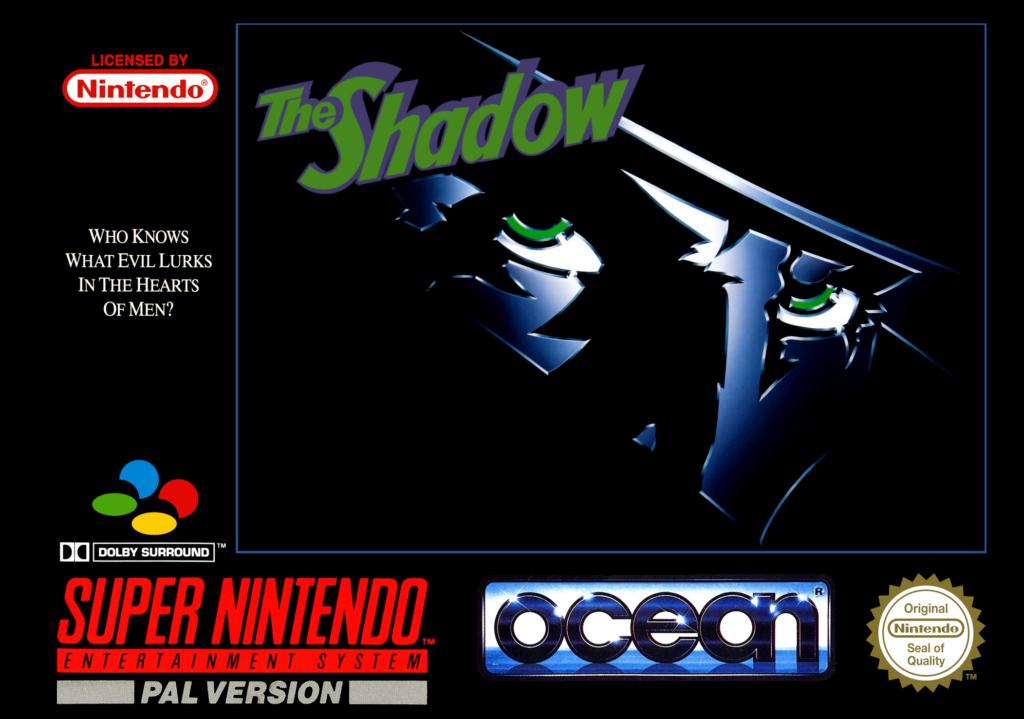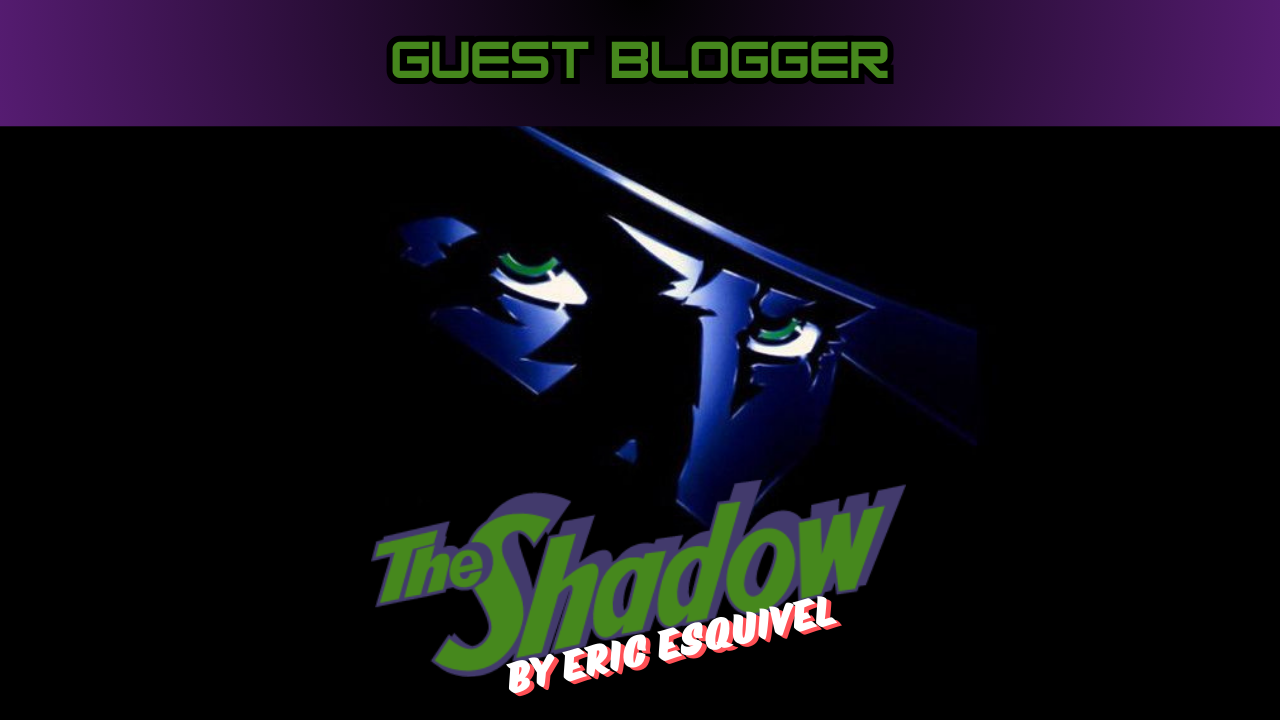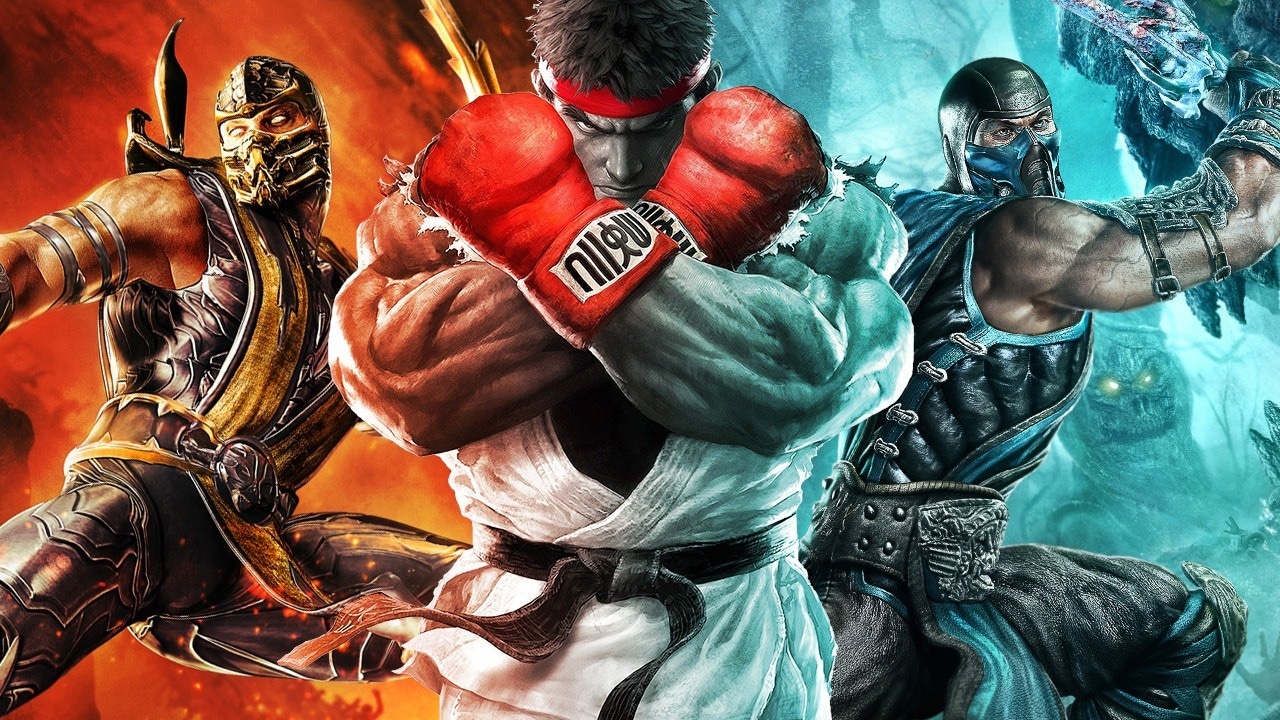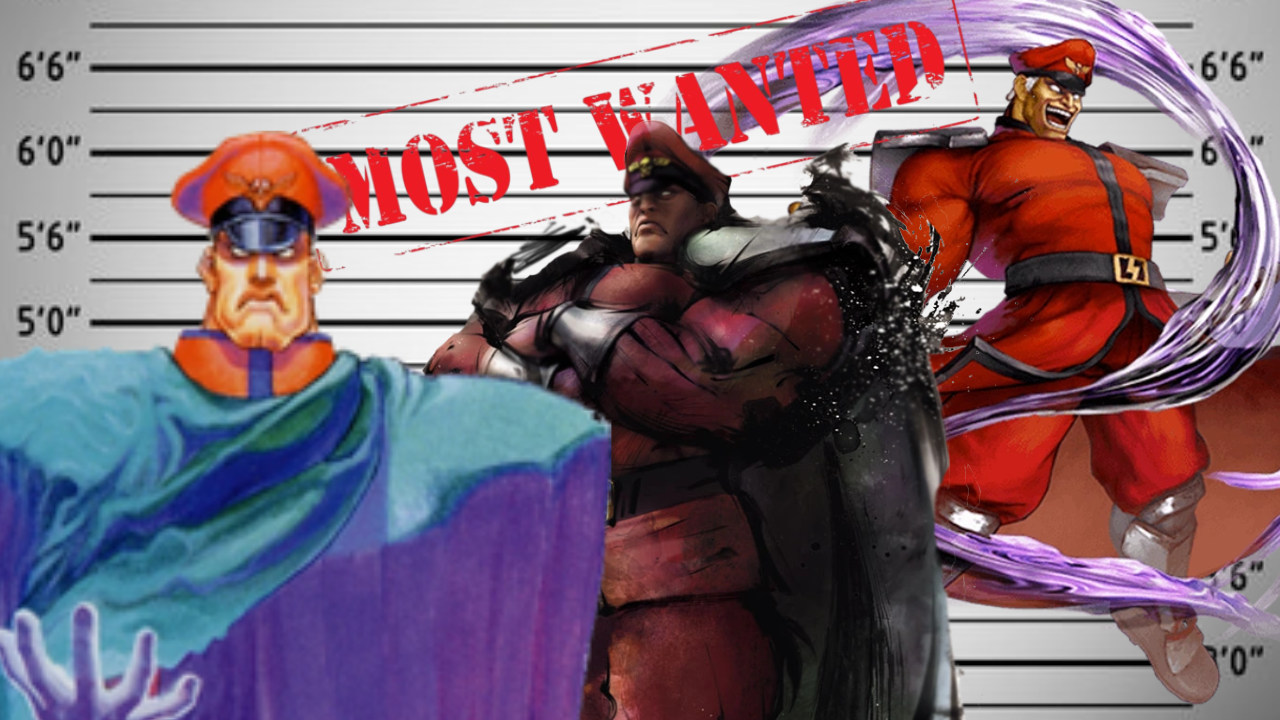By: Eric Esquivel – ericMesquivel@gmail.com
The great irony of The Shadow’s enduring pop culture relevance is that, every step of the way, his stories have been produced in the most ephemeral medium of their era. From the radio shows (designed to air once, and never be distributed as permanent recordings), to the “pulp” magazines that practically disintegrated in one’s hands as one read them, to the B-movie cash-grab in the 1990’s which was hurriedly (and cynically) put into production to soak up any remaining nerd-money after 1989’s Batman.
And, yet, the sincerity and the craftsmanship of each generation of The Shadow’s scribes always manages to elevate their material above the medium for which it was created.
Such is the case with Ocean Software’s 1994 video game, THE SHADOW: THE GAME.

Designed by Brian Flanagan and Ivan Davies for the then-state-of-the-art video game console, The Super Nintendo, THE SHADOW: THE GAME takes full advantage of the technology of the time to create an interactive storytelling experience that is everything a pulp fan in the nineties could’ve dreamed for.
“New York, 1933. A city soon to be thrown into chaos… Shiwan Khan, the last descendant of the barbaric Ghengis Khan, plans to destroy the city with a devastating device. The only person equal in power to bring Khan’s twisted plans to an end is a mysterious defender of justice, a man cloaked in darkness… THE SHADOW, a man with the ability to cloud the minds of the weak and corrupt, also to see the evil which boils in men’s hearts. Who knows what evil lurks in the hearts of men? THE SHADOW! ”. That’s the Star-Wars-style screen crawl that introduces the world of Pulp Fiction’s shadiest superhero before dropping the player into a sixteen bit Neon Noir nightmare, populated entirely by bloodthirsty gangsters and self-styled barbarians who want to burn New York City to the ground.
For the first half of the level, The Shadow (who, as diehard fans are well aware, normally isn’t known for his restraint) doesn’t pull iron. He relies solely on his masteries of both the martial and mystic arts to dispatch his foes—kicking, punching, and dipping into his finite (and slowly-regenerating) “power bar” to turn invisible, devastate them with a blast of psionic energy, and dash forward at telekinetically-enhanced speed. When any of those tactics fail, The Shadow has the ability to rip up parts of the game’s scenery and utilize leaded pipes and wooden planks as lethal weapons in crusade against the sinister Shiwan Khan.

Only when you’re halfway through the level, and a couple of thugs named “Paulo” and “Rico” point their Tommy guns at him, does The Phantom unholster his signature .45’s and put crime in his crosshairs— switching the genre of the game from “Sidescroller Beat ‘Em Up” to “Third-person Shooter”.
And this is not the only time that THE SHADOW: THE GAME switches genres on players, just as they’re getting comfortable. In the game’s fifth level, The Pulpy Protector commandeers one of Shiwan Khan’s minion’s motorcycles and chases the modern day mongols through the streets of a stylized, Art Deco Lower Manhattan.
In short, THE SHADOW: THE GAME isn’t just one game—it’s three; combining the best elements of other entries in the Super Nintendo Cannon like STREETS OF RAGE, THE PUNISHER, and MARIO KART, to make something wholly unique and fun. Especially for the time period in which it was created.
…Which is why it’s so damn confusing that the game never saw the light of day. At least, not on the consumer side. A fully playable eight level demo was fully completed and sent to various video game review outlets to review. NINTENDO POWER #67’s review of the game boasted “Fortunately, it makes a better video game than a movie”. And Next Generation #3’s review opined “Fan of the character will be glad that The Shadow’s steadfast, undefinable power to ‘cloud men’s minds’ has been incorporated. If only in the form of a few special attacks. The game show good graphics, includes a nice soundtrack.”
While the reviews weren’t exactly glowing, they weren’t bad either. Especially coming from critics who had little to no interest in the character, or the Pulp Hero genre in general.
So then why was the game not produced?
Most likely, the movie that came out the same year is to blame. While THE SHADOW: THE GAME isn’t necessarily a one-for-one adaptation of the Russell Malcahy and David Koepp’s film (for one: the visuals owe more to Jim Steranko’s bright, lurid pulp cover illustrations than to Alec Baldwin’s portrayal of Lamont Cranston), the film did loose an awful lot of money at the box office. In fact, it was reported that the film’s budget was $40 million dollars…but it only brought in around forty eight. Which is, of course, a nightmare scenario for the beancounters in Universal Studio’s accounting department who expected it to gross closer to Batman ($400 million) and Dick Tracy ($162 million).

Of course, as us fans of The Shadow know, the character’s popularity isn’t tied to one film. The nearly-a-century-old character has appeared in literally hundreds of radio broadcasts, film serials, comic books and novels. It would take way more than one bad showing at the cinema to kill the public’s interest in Walter B. Gibson’s enigmatic avenger. Surely there would have been audience for the game, had Ocean Software found the testicular fortitude to take a gamble and put it out. In fact, there’s copious amounts of evidence to prove that to be true. As of the writing of this article— exactly thirty years after the game was set to release— there is still a surprisingly strong market for bootleg copies of the game, online. Both as digital emulations, and as actual physical cartridges. In fact, a quick search on Etsy reveals literally dozens of lovingly hand-crated (and tremendously illegal) bootleg SNES cartridges, with a fully playable ‘port of the game uploaded to the chip inside. Art for the accompanying labels and box art has been sourced from all over The Shadow’s ninety three year history: paperback covers, graphic novel panels…even stills and poster art from the critically maligned movie—which lives on in the hearts and minds of its devoted fans as a bonafide “cult classic”.
The Shadow knows what evil irks in the heart of men…but nobody knows who leaked the game’s data online, thereby making all of these charming little counterfeits possible. But rumors abound. The likeliest possibilities are either: a former critic for a game magazine who was a fan of the demo and decided to go all “Robin Hood” and illegally release it online so other fans could play it too; or a disgruntled former staffer at Ocean who was irritated that his or her kick-ass efforts (probably taking a year or more to compete) went unrecognized
Whoever that anonymous, brave soul happens to be: good on ‘em! At the risk of self-incriminating…I bought one. I know what you’re thinking: “How could you? Don’t you know that ‘The weed of crime bears bitter fruit!’?”. And, yes, of course I do. But this thing is incredible. Holding it feels like getting my hands on some impossible artifact from a better, cooler world. A world wherein people don’t let fully produced works of art die just because they’re scared that they might not make a billion dollars.

But, while the real world rarely has perfect endings, THE SHADOW: THE GAME does. After punching, kicking, shooting, and mind-blasting his way through eight levels of 1930’s-style ultra violence, a triumphant theme rings out in glorious chiptune fashion while the final text crawl of the game reads fills the screen: “The city of New York is safe from the threat of devastation and Khan is safely behind bars in a mental institute, lobotomized by the flying glass in the battle with The Shadow”.
Phew, Thank God.
Why there haven’t been any plans to create a new The Shadow game for the current generation of consoles is a mystery that only Margo Lane could solve. Especially with a market inundated by both first-person-shooters and superhero IP’s (with The Shadow being a perfect blend of both). Maybe the rumored The Shadow reboot (allegedly starring FANTASTIC FOUR and CAPTAIN AMERICA’s Chris Evans) will come out, and there will be a tie-in to that. Or perhaps Art OF Play’s THE PHANTOM video game will hit its proposed December 2024 release date and usher in a whole new era of video game publishers scrambling to pick up classic pulp hero “intellectual property” (imagine The Shadow standing alongside The Avengers and Doc Savage in Fortnite).
One thing is for sure, though: whatever the next big technological fad in storytelling is, The Shadow will be there. There’s something about the idea of an unrelenting, merciless force for Justice that transcends time and trends. I wouldn’t be surprised if the next generation found a way to transport Street and Smith’s most popular creation into virtual reality, or whatever cybernetic/psychedelic story delivery system comes after that. But they’ll all owe a debt to The Super Nintendo’s THE SHADOW: THE GAME for being the first ever interactive Shadow story.
Be sure to check out more of Eric’s stuff by following his links below:
INSTAGRAM: https://www.instagram.com/emecomics




